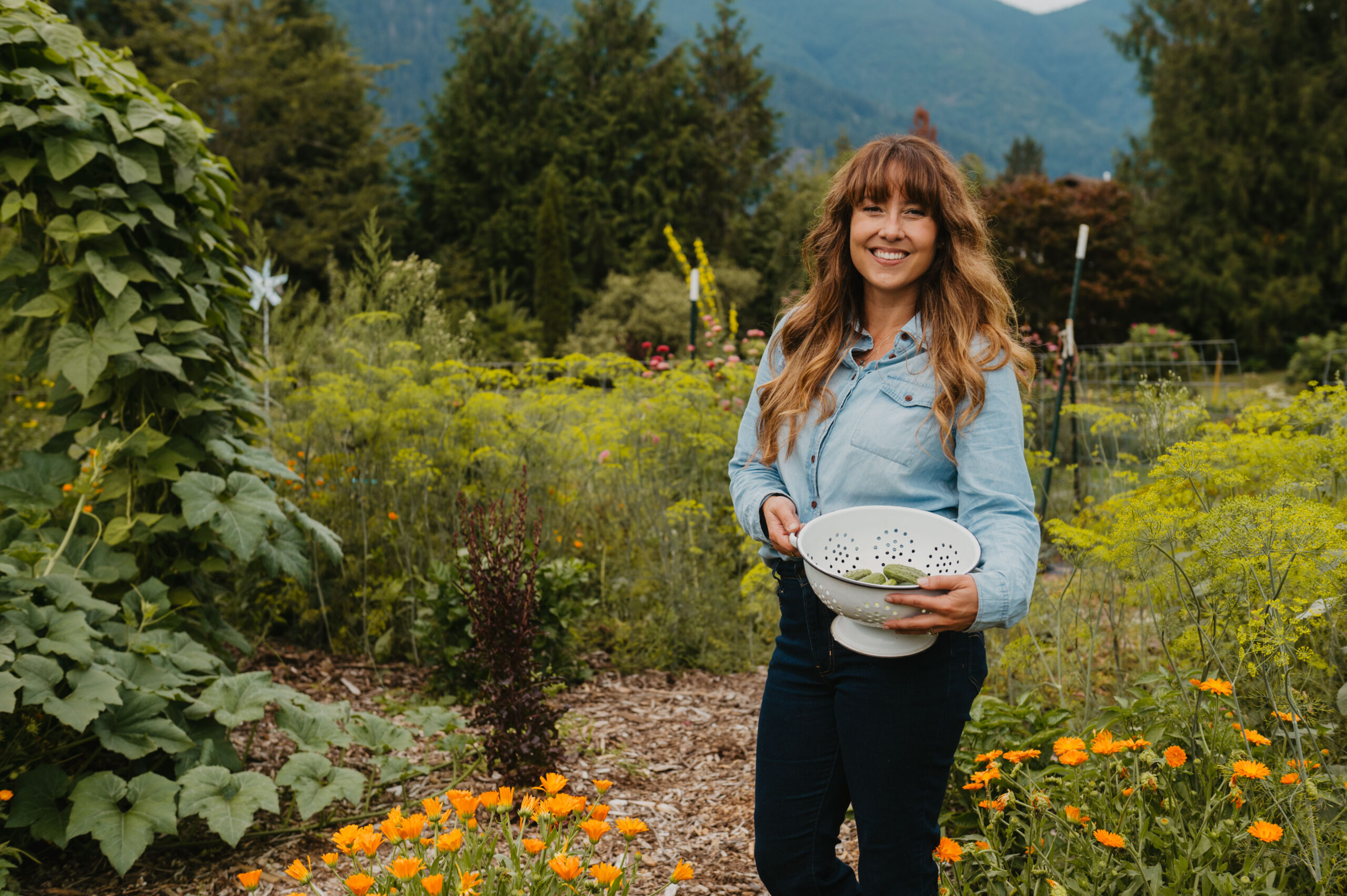As summer winds down and we head into fall, the garden changes right along with the seasons. It’s one of my favorite times to walk through the rows, see what’s thriving, what needs attention, and share some tips I’ve learned from my own homestead garden here in the Pacific Northwest.

If you’ve ever struggled with winter squash not ripening in time, peppers getting sunscald, or figuring out how to squeeze just a little more out of your broccoli and cabbage, these tips are for you. Let’s dive in!

There’s nothing more frustrating than tending winter squash all summer long only to have frost hit before they’re ripe. In my experience, if the squash isn’t already partially ripened when frost comes, it won’t continue ripening off the vine with the same flavor or sweetness.
Here’s what I do:
Pro Tip: This works especially well with delicata and other smaller winter squash, but it can also make a difference for larger varieties.

Melons have been a challenge for me. For years, even with greenhouse starts and early planting, I never got a melon to fully mature. But this year, I tried the same vine-tipping method that works on squash, and it’s been a game-changer!
After tipping back the vines just a week earlier, I saw real progress. Blossoms developed into small melons, and existing fruits grew quickly.
Now, I won’t know until frost whether they fully ripen, but this is the most success I’ve had yet. I may even tip them earlier next year!
If you live in a cooler climate or short growing season area, give this a try. Cut back the growing tips a month or so before frost, and you may finally get melons to mature before the cold sets in.

Peppers love heat, but direct sun can sometimes cause problems, especially when fruits are exposed without enough leaf cover.
I discovered one of my red bell peppers had developed sunscald. The damaged part of the pepper isn’t usable, but the rest of the fruit is perfectly fine. Just cut away the sunscalded section and enjoy the rest.
To help prevent future damage, make sure your peppers have good leaf coverage or provide a little light shade during the hottest part of the day.
For hot peppers, I also use cold frames to hold in warmth. Just be careful they don’t overheat. A lid that can vent automatically as temperatures rise is a great tool for balancing heat and airflow.

One of the biggest mistakes gardeners make is pulling out broccoli or cabbage plants after harvesting the first large head. But if you leave them in the ground, you’ll often get a second harvest of smaller side shoots or mini heads.
This works wonderfully with broccoli (pictured above). After cutting the main head, my plants produced numerous side shoots that grew into smaller, but still very usable, florets.
Cabbage will do the same thing. After harvesting the main head, the plant will often send out several mini heads. They won’t get as big as the first, but they’re perfect for coleslaw, stir-fry, or even small-batch sauerkraut.
The lesson? Don’t be too quick to pull your brassicas. They can keep producing long after that first big harvest.
Basil is one of those herbs that loves heat but can go to flower quickly in late summer. Once it starts to flower, the plant will put its energy into seed production instead of leaves. Pinch back any flowers to encourage more leaf growth, and harvest regularly to keep the plant productive.
The best time to harvest basil is in the morning, before the sun is hot, when the leaves hold the highest concentration of essential oils.
One of my favorite ways to preserve basil so it actually tastes fresh months later is to make basil salt. It’s an old-fashioned preservation method that keeps the vibrant flavor far better than dehydrating.
Every garden season teaches me something new. By pruning squash and melon vines, shading peppers, letting broccoli and cabbage regrow, and harvesting basil at the right time, you can stretch your harvest and improve the flavor of your crops.
These small adjustments can make a big difference in how much food you bring in before frost. And the best part? They’re easy steps any gardener can try, no matter the size of your plot.
Happy gardening, and here’s to enjoying every last bit of summer’s bounty before the cooler days arrive!
The post End-of-Summer Garden Tips appeared first on Melissa K. Norris.

If you’ve ever struggled with winter squash not ripening in time, peppers getting sunscald, or figuring out how to squeeze just a little more out of your broccoli and cabbage, these tips are for you. Let’s dive in!
How to Get Winter Squash to Ripen Before Frost

There’s nothing more frustrating than tending winter squash all summer long only to have frost hit before they’re ripe. In my experience, if the squash isn’t already partially ripened when frost comes, it won’t continue ripening off the vine with the same flavor or sweetness.
Here’s what I do:
- About four to six weeks before your average first fall frost, go out to your squash patch and look at your vines. Often, the plant is still pushing out blossoms or long vines that won’t have time to develop into mature fruit.
- Take a sharp pair of pruners and cut those vines back. This signals the plant to stop pouring energy into new growth and instead put all of its resources into ripening the squash already on the vine.
Pro Tip: This works especially well with delicata and other smaller winter squash, but it can also make a difference for larger varieties.
My Breakthrough with Growing Melons in a Short Season

Melons have been a challenge for me. For years, even with greenhouse starts and early planting, I never got a melon to fully mature. But this year, I tried the same vine-tipping method that works on squash, and it’s been a game-changer!
After tipping back the vines just a week earlier, I saw real progress. Blossoms developed into small melons, and existing fruits grew quickly.
Now, I won’t know until frost whether they fully ripen, but this is the most success I’ve had yet. I may even tip them earlier next year!
If you live in a cooler climate or short growing season area, give this a try. Cut back the growing tips a month or so before frost, and you may finally get melons to mature before the cold sets in.
Preventing Sunscald on Peppers

Peppers love heat, but direct sun can sometimes cause problems, especially when fruits are exposed without enough leaf cover.
I discovered one of my red bell peppers had developed sunscald. The damaged part of the pepper isn’t usable, but the rest of the fruit is perfectly fine. Just cut away the sunscalded section and enjoy the rest.
To help prevent future damage, make sure your peppers have good leaf coverage or provide a little light shade during the hottest part of the day.
For hot peppers, I also use cold frames to hold in warmth. Just be careful they don’t overheat. A lid that can vent automatically as temperatures rise is a great tool for balancing heat and airflow.
Don’t Pull Broccoli and Cabbage Too Soon

One of the biggest mistakes gardeners make is pulling out broccoli or cabbage plants after harvesting the first large head. But if you leave them in the ground, you’ll often get a second harvest of smaller side shoots or mini heads.
This works wonderfully with broccoli (pictured above). After cutting the main head, my plants produced numerous side shoots that grew into smaller, but still very usable, florets.
Cabbage will do the same thing. After harvesting the main head, the plant will often send out several mini heads. They won’t get as big as the first, but they’re perfect for coleslaw, stir-fry, or even small-batch sauerkraut.
The lesson? Don’t be too quick to pull your brassicas. They can keep producing long after that first big harvest.
Harvesting Basil at the Right Time
Basil is one of those herbs that loves heat but can go to flower quickly in late summer. Once it starts to flower, the plant will put its energy into seed production instead of leaves. Pinch back any flowers to encourage more leaf growth, and harvest regularly to keep the plant productive.
The best time to harvest basil is in the morning, before the sun is hot, when the leaves hold the highest concentration of essential oils.
One of my favorite ways to preserve basil so it actually tastes fresh months later is to make basil salt. It’s an old-fashioned preservation method that keeps the vibrant flavor far better than dehydrating.
Every garden season teaches me something new. By pruning squash and melon vines, shading peppers, letting broccoli and cabbage regrow, and harvesting basil at the right time, you can stretch your harvest and improve the flavor of your crops.
These small adjustments can make a big difference in how much food you bring in before frost. And the best part? They’re easy steps any gardener can try, no matter the size of your plot.
Happy gardening, and here’s to enjoying every last bit of summer’s bounty before the cooler days arrive!
More Posts You May Enjoy
- Small Space Vegetable Gardening Urban Gardening Tips
- 8 Common Mistakes Made by New Gardeners
- Direct Sowing Seeds Successfully in the Garden
- Does Gardening Save Money
- Vertical Garden Planning & Expanding Growing Spaces
The post End-of-Summer Garden Tips appeared first on Melissa K. Norris.
